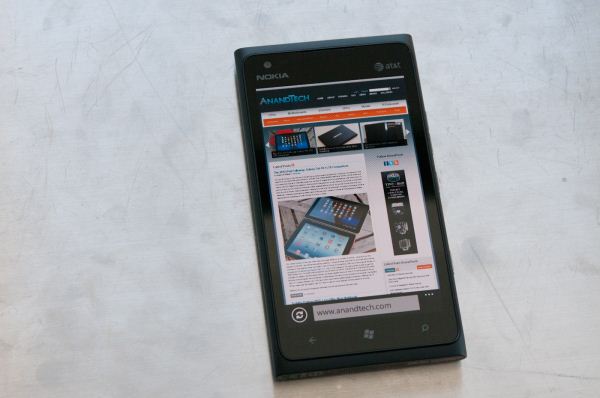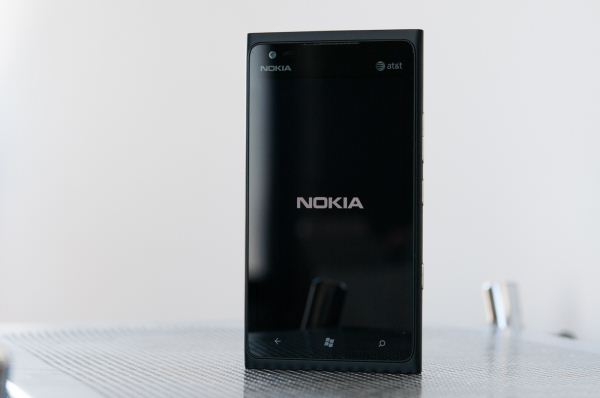Nokia Lumia 900 Review - Windows Phone with LTE
by Brian Klug on April 3, 2012 9:00 PM ESTSumming up the Lumia 900 as a device is pretty easy, it's superficially a beefed up, larger Lumia 800. Spelled out explicitly, the changes are a larger 4.3" SAMOLED+ display with a full RGB stripe, a front facing 720p camera, and LTE connectivity for AT&T. When it launches later in Europe, instead of LTE, the Lumia 900 will bring DC-HSPA+ and all around improved cellular connectivity courtesy MDM9200. The Lumia 900 is thinner, but obviously larger in x and y to accommodate the larger display, but in the hand and pocket the difference isn't all that huge. The end result is a device I can find only positive things to talk about with, and it's the Lumia that finally rounds out Nokia's complete entrant Windows Phone lineup.
For the first time in a while, I'm genuinely excited by a new Windows Phone. With the Lumia 900, it seems as though some of Nokia's rhetoric about being the first OEM to put its best hardware and design forward with the platform is starting to ring true. Similar to our take on the first members of the Lumia family, the 900 is easily the best Windows Phone on the market today.
The $99 launch price is absolutely crazy and very welcome for a flagship phone, particularly one with such high build quality and camera standards. Not only does this obviate other Windows Phones, but it increases competitive pressure on Apple as well as Android smartphone providers. I don't know that there's still a lot of iPhone/Windows Phone cross shopping, but a trend towards even cheaper on-contract prices for high-end smartphones is absolutely welcome.
What we really need to see from Nokia is faster hardware and more power efficient LTE, both of these things are technically possible today (28nm LTE basebands are still not quite available in volume yet) however it's up to Microsoft to actually enforce the platform change. It's amazing what Nokia has been able to do hardware-wise with only a year in the Microsoft camp, particularly when you remember that most smartphone development cycles are in the 12 - 24 month range. While the Lumia 900 is a great Windows Phone today, what will really be interesting is what Nokia will be able to pull off with a full design cycle under its belt.
The Lumia 900 launch in the US is, like I stated before, obviously a big deal for Nokia, and putting its best devices on the table with the 900 makes sense, even if the initial Lumia 710 introduction was something of a puzzling first step. While it's a big deal for Nokia to be launching a flagship phone in the US once more, it really isn't as much of a make or break thing for the Windows Phone 7 platform in general, and that brings me to my next point.
Ultimately the Lumia 900 doesn't really change the balance of power in the smartphone OS competition as it stands right now. Although the version number has advanced on the Lumia 900 (because of changes that needed to accommodate LTE), it's really the same Windows Phone 7.5 Mango we've seen and talked about before. If you're looking for a make or break launch that might upset the balance, wait for the Apollo update.
As it enables dual-core SoCs, the Apollo update leads to our continued plea to Microsoft: please throw better hardware at the Windows Phone platform. No company ever won by being the slowest. Windows Phone may be an extremely efficient platform (it is), but there are only good things to come from combining software efficiency with bleeding edge hardware. Microsoft has learned tremendously from Apple in this regard, but in order for Windows Phone to be more than a third runner up it needs to push the envelope just as much as Apple has been. Microsoft will eventually adopt Krait, and 28nm LTE is equally inevitable, but it would just be nice to see those things sooner rather than later on Windows Phone. At some point for a platform to be a winner, it must actually be industry leading. I suspect all of this will come as a part of Microsoft's Windows 8 strategy. Waiting is never easy.












128 Comments
View All Comments
Beerfloat - Thursday, April 5, 2012 - link
Yup, I guess there's always a next best thing around the corner in the tech industry. Krait is pretty cool. But then, A15 bundled with a fast SGX or Mali GPU will be cooler still. Tegra 3 does have the benefit of the low power 5th core, plus, for right or for wrong, Nvidia always seems to bring the little extra member benefits.tipoo - Thursday, April 5, 2012 - link
True, but the Krait version of the One X isn't that far away, compared to A15 and all that. The Krait One S is already shipping. And Nvidia's fifth core doesn't help it against Kraits battery life, look at the One S with Krait, it gets significantly higher life (to be fair, some will be the screen, but still). Tegra Zone optimizations apart, Krait is nearly uniformly better.jed22281 - Sunday, April 8, 2012 - link
typical moronic response.ecuador - Wednesday, April 4, 2012 - link
If more people got their hands on the N9's it would not be a dead OS. Even people with the latest iphones are amazed when they try out the N9, something I have never seen with, say, an Android phone.That's why I complain about tech sites not trying to give the N9 the chance that Nokia did not want it to have - it is (was?) by far the most promising mobile OS (not to mention the most open).
jed22281 - Sunday, April 8, 2012 - link
Maemo6x (meego-harmattan) used by the N9 is far from being the most open.Tizen & WebOS are far more open, even Android is arguably....
If it had been given time to evolve into real MeeGo* it would've been w/o question.
There's MeeGo derivatives floating about still (MeR + Nemo/Plasma etc)
But they're more underdeveloped than they would've been, had resources not been dropped hugely in the past 14mth.
*which would've completed by July 12' at the latest w/the 1st x86 phone, after the 3rd Harmattan ph started reaching shelves.
jed22281 - Sunday, April 8, 2012 - link
typical moronic response.Tujan - Wednesday, April 4, 2012 - link
Excellent article about a cell phone from anandtech.com !...
With the exception of memory bandwidth this is certainly a great little computer radio phone.
....
"Waiting is never easy" <- catchy. !
Origin32 - Wednesday, April 4, 2012 - link
And of course half of the comments are about Android phones being slow. Yes, the UI is less smooth than iOS of WP. But I really don't care about that and I can't be the only one. In my humble opinion functionality is king, and whether my homescreen renders at 20fps or 60 doesn't really matter. Android has some great features that I am yet to see in iOS or WP. Having borrowed an iPhone for a couple hours I already found it to be incredibly constraining and the lack of a back or menu button annoyed the crap out of me. As for WP, I played around with a Lumia 800 for a while but all the sidescrolling in the homescreen and in apps was very confusing. It made the display feel too narrow.Plus, I bet you'll all be glad we have quadcore smartphones when they've become so fast you can ditch your laptop, but of course most of you never even considered that :)
valhar2000 - Wednesday, April 4, 2012 - link
People around here keep talking about the superior feature set of Android. What are these features that other phone OSs don't have?Beerfloat - Wednesday, April 4, 2012 - link
Well, HD screens for one. Grown up DPI-independent rendering for another. A choice of different form factor devices to suit various usage patterns and budgets. Multiple software stores, an enormous amount of apps, close integration with Google services (if so desired), wonderful customizability, the most straightforward interaction with other devices like PCs (it's just an USB disk drive, plus it talks CIFS).But oh well.